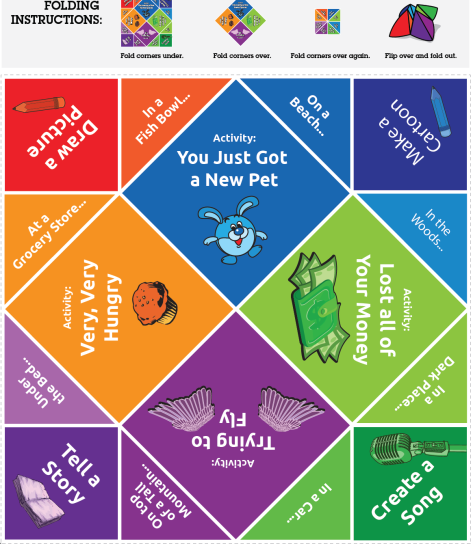Choice + Imagination = Fantastic Results
Destination Imagination (DI) has been recommended by my supervisor for use with gifted students. I teach gifted students at two Title 1 elementary schools.
DI MISSION
To engage participants in project-based challenges that are designed to build confidence and develop extraordinary creativity, critical thinking, communication, and teamwork skills
DI PRINCIPLES
- Fun learning: Explore STEM/STEAM concepts in a hands-on environment
- Creative problem solving: Learn how to think, not what to think
- Kid powered; team driven: Energize students to own all decisions, creations, and results
- Friendly competition: Motivate teams to reach for the stars, while also rooting for each other
- Global diversity: Encourage and celebrate differences in each other, and differences in ideas.
(https://www.destinationimagination.org/vision-mission/)
Destination Imagination has developed Instant Challenges to help spark student creativity. Recently, I had one class of gifted 6th graders do the Fortune Teller Instant Challenge. See below.

Here is a PDF that leads to the several versions of the Destination Imagination Fortune Teller: Destination_Imagination_IC_Makers PDF
I only have four students in this particular class and interestingly, each selected a different project:
- Tell a Story About Being Very, Very Hungry at a Concert
- Make a Cartoon About Getting a New Pet in a Fishbowl
- Create a Song About Trying to Fly at an Amusement Park
- Create a Commercial About Trying to Fly at an Amusement Park
They (except for the cartoon) recorded their projects in front a green screen and then added background images using iMovie. Here are their finished creations:
They had 100% engagement throughout the project. This is significant as two of the girls sometimes have a difficult time getting and staying focused on their projects during class. I believe this occurred because they were given a choice and they had to use their imaginations.
Choice
I have blogged about giving student voice and choice in the past.
Education works when people have opportunities to find and develop unaccessed or unknown voices and skills. Audre Lorde poignantly describes this “transformation of silence into language and action [as] an act of self-revelation.” Opportunities for flexibility and choice assist learners in finding passion, voice, and revelation through their work. (http://www.edutopia.org/blog/student-choice-leads-to-voice-joshua-block)
Internet accessibility, technologies that permit the user-generated media, and social media allow for unlimited potential for learner choice and voice.
Learner Choice can be facilitated through:
- Giving learners choice in how they want to learn content including through videos, text-based resources, podcasts, hands-on modules, or human interactions (see UDL’s multiple means of representation).
- Giving learners choices to show what they know-what they learned through anything from writing a paper to creating a multimedia presentation to creating a performance art work (see UDL’s multiple means of action and expression).
- Giving learners choice to study topics based on personal interests as it facilitates natural engagement in learning (see Interest Fuels Effortless Engagement).
- Being a tour guide of learning possibilities – show learners the possibilities and then get out of the way (see https://usergeneratededucation.wordpress.com/2015/07/26/show-learners-the-possibilities-and-then-get-out-of-the-way/).
Imagination
I believe that most of student learning should contain some form of them using their imaginations. Sadly, though as Sir Ken Robinson noted over ten years ago, “schools are killing creativity.”
According to research conducted by Kyung Hee Kim, Professor of Education at the College of William and Mary, all aspects of student creativity at the K-12 level have been in significant decline for the last few decades. Based on scores from the Torrance Tests of Creative Thinking, her study reveals “that children have become less emotionally expressive, less energetic, less talkative and verbally expressive, less humorous, less imaginative, less unconventional, less lively and passionate, less perceptive, less apt to connect seemingly irrelevant things, less synthesizing, and less likely to see things from a different angle” (How America’s Education Model Kills Creativity and Entrepreneurship).
From my blog post, Intentional Creativity:
Embedding creativity into the curriculum can and should be a strong component of content area teaching and learning. In other words, educators don’t need to plan to teach creativity as another part of curriculum. Creativity is often an integral part of the practices of professionals including scientists, mathematicians, business people, artists, writers, and is an important part of their content area expertise. It follow, then, that learners should be taught in ways that help them think like a scientist . . . like an artist . . . like a writer . . . like a business person.

Choice + Imagination = great opportunities for learning.
Norah
October 29, 2018 at 10:45 am